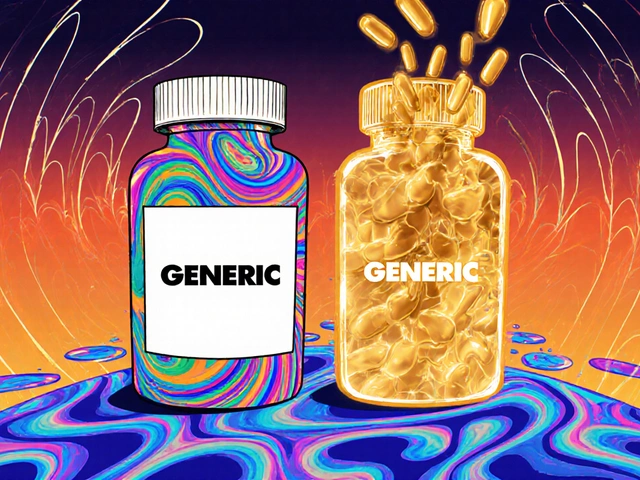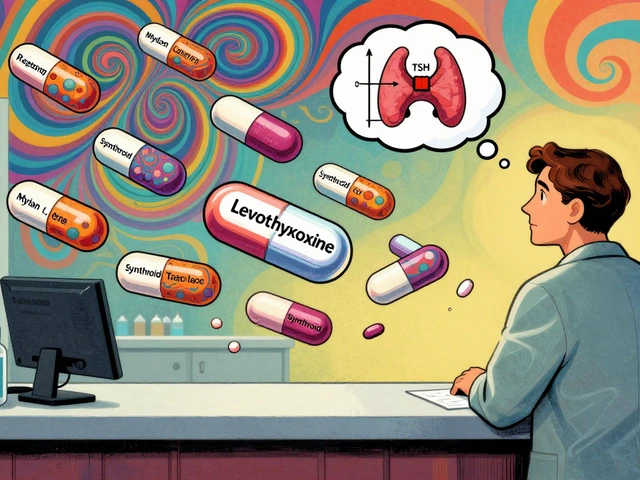
HIV NRTI Drug Comparison Tool
Select Criteria for Comparison
Recommended Drugs Based on Your Criteria
| Drug | Efficacy | Safety | Cost | Dosing |
|---|---|---|---|---|
| Lamivudine | 88-90% | Low | £30 | Once Daily |
| Tenofovir (TDF) | 88-92% | Moderate | £55 | Once Daily |
| Tenofovir (TAF) | 90-94% | Low | £58 | Once Daily |
| Emtricitabine | 89-91% | Low | £45 | Once Daily |
| Zidovudine | 70-75% | High | £55 | Twice Daily |
| Abacavir | 92-94% | Moderate | £50 | Once Daily |
TL;DR
- Lamivudine (Epivir) is a well‑tolerated NRTI with strong resistance barrier when combined with other drugs.
- Tenofovir (TDF/TAF) offers higher potency but carries renal and bone concerns.
- Emtricitabine is almost chemically identical to lamivudine, often paired with tenofovir.
- Zidovudine is older, more toxic, and usually reserved for special cases.
- Abacavir provides excellent viral suppression but requires HLA‑B*57:01 testing.
What is Lamivudine?
When treating HIV, Lamivudine is a nucleoside reverse‑transcriptase inhibitor (NRTI) marketed as Epivir, used to halt viral replication. It was first approved in 1995 and has become a backbone of many combination regimens because of its low toxicity and once‑daily dosing.
How Lamivudine Works
Lamivudine mimics the natural nucleoside cytidine. Once inside a CD4+ cell, it is phosphorylated to its active triphosphate form, which then competes with the natural substrate of HIV reverse transcriptase. By getting incorporated into the viral DNA chain, it causes premature termination, preventing the virus from copying its genome.
Key Criteria for Comparing HIV NRTIs
Before diving into alternatives, you’ll want to line up the factors that matter most in real‑world decision‑making:
- Efficacy: % of patients achieving undetectable viral load in clinical trials.
- Safety profile: Common and serious adverse events.
- Resistance barrier: How quickly the virus can develop mutations that render the drug ineffective.
- Convenience: Dosing frequency and pill burden.
- Cost: Approximate monthly price in the UK (2025 data).
Alternative #1: Tenofovir (TDF & TAF)
Tenofovir comes in two formulations. Tenofovir disoproxil fumarate (TDF) was the original version, while Tenofovir alafenamide (TAF) is a newer pro‑drug designed to deliver the active molecule more efficiently to lymphoid cells.
Both are NRTIs with a high genetic barrier. TDF is dosed at 300mg once daily and has been a staple of the once‑daily “Truvada” regimen. TAF allows a lower dose (25mg) with markedly reduced kidney and bone toxicity, making it attractive for older patients or those with pre‑existing renal issues.
Clinical trials (e.g., IMPAACT 2013) show viral suppression rates of 88-92% after 48weeks, comparable to lamivudine‑based combos. However, TDF’s impact on glomerular filtration rate (average 5mL/min decline) and bone mineral density (≈2% loss) remain concerns. TAF mitigates these effects, with only a 0.5mL/min change in the same studies.
Alternative #2: Emtricitabine
Emtricitabine is a nucleoside analogue closely related to lamivudine, also marketed as FTC. Like lamivudine, it is phosphorylated to an active triphosphate that stops reverse transcription.
The drug is usually paired with tenofovir (as in “Descovy”). Compared with lamivudine, emtricitabine has a slightly longer intracellular half‑life, allowing a once‑daily 200mg dose. Its safety profile mirrors lamivudine-headache, nausea, and mild rash are the most common complaints.
In head‑to‑head studies (e.g., ACTG 5256), viral suppression rates were virtually identical (89% vs. 90%). Cost-wise, emtricitabine is a bit pricier in the UK, averaging £45 per month versus £30 for lamivudine.

Alternative #3: Zidovudine
Zidovudine (AZT) was the first NRTI approved for HIV in 1987. It works the same way-chain termination-but its toxicity profile is less forgiving.
Zidovudine is given twice daily (300mg each dose). While early trials reported 70-75% suppression, modern regimens favor newer agents because AZT can cause anemia, neutropenia, and significant gastrointestinal upset.
Resistance emerges quickly; the M184V mutation that also reduces lamivudine susceptibility actually makes the virus more sensitive to AZT, a paradox used in some salvage therapies. In the UK, AZT costs around £55 per month, reflecting its lower demand.
Alternative #4: Abacavir
Abacavir (ABC) is a guanosine analogue NRTI. It must be prescribed only after a patient tests negative for the HLA‑B*57:01 allele, as the allele predicts a severe hypersensitivity reaction.
When used in combination with lamivudine (as in the fixed‑dose “Kivexa”), abacavir provides excellent viral control-studies such as the HEAT trial report >92% suppression at 48weeks. Side effects are generally mild (headache, fatigue), but the hypersensitivity risk (≈5% in allele‑positive individuals) mandates pre‑screening.
Abacavir is dosed once daily at 600mg and costs roughly £50 per month in the UK. Its high barrier to resistance makes it a solid choice for patients intolerant to tenofovir.
Side‑by‑Side Comparison Table
| Drug | Class | Typical Dose | Viral Suppression (48wks) | Common Side Effects | Resistance Barrier | UK Cost / month (2025) |
|---|---|---|---|---|---|---|
| Lamivudine (Epivir) | NRTI | 300mg once daily | 88-90% | Nausea, headache, mild rash | High (M184V reduces efficacy but increases susceptibility to other NRTIs) | £30 |
| Tenofovir disoproxil fumarate (TDF) | NRTI | 300mg once daily | 88-92% | Renal tubular dysfunction, bone loss | Very high | £55 |
| Tenofovir alafenamide (TAF) | NRTI | 25mg once daily | 90-94% | Weight gain, mild lipid rise | Very high | £58 |
| Emtricitabine (FTC) | NRTI | 200mg once daily | 89-91% | Headache, nausea | High | £45 |
| Zidovudine (AZT) | NRTI | 300mg twice daily | 70-75% | Anemia, neutropenia, GI upset | Low | £55 |
| Abacavir (ABC) | NRTI | 600mg once daily | 92-94% | Hypersensitivity (HLA‑B*57:01), fatigue | High (requires allele screening) | £50 |
Choosing the Right NRTI for You
Every patient’s situation is unique. Below are quick decision guidances based on the comparison criteria:
- If kidney health is a concern: Prefer TAF over TDF, or stick with lamivudine or emtricitabine.
- When pill burden matters: Lamivudine, emtricitabine, and abacavir all need a single daily tablet.
- Cost‑sensitive patients: Lamivudine remains the cheapest option.
- High resistance risk: Pair lamivudine with a high‑barrier agent like TAF or abacavir.
- Allergy or HLA‑B*57:01 positivity: Avoid abacavir, consider lamivudine‑based combos.
Discuss these points with your HIV specialist; they can run resistance tests, assess organ function, and tailor the regimen to your lifestyle.
What About Fixed‑Dose Combinations?
Many clinicians favor single‑tablet regimens (STRs) to simplify adherence. Examples include:
- Triumeq: Abacavir+lamivudine+dolutegravir.
- Descovy: Emtricitabine+TAF+bictegravir.
- Generic Tenofovir‑Lamivudine combos for low‑resource settings.
STRs can shave minutes off daily routine, but they also lock you into a specific drug pair. If you need to switch one component due to side effects, you may lose the convenience.
Future Directions in NRTI Therapy
Research is pushing beyond traditional NRTIs. Long‑acting injectable forms (e.g., cabotegravir + rilpivirine) are gaining traction, though they still pair with an NRTI backbone. New pro‑drugs aim to further reduce renal impact, and gene‑editing approaches are in early trials. Until those become mainstream, lamivudine and its peers remain the workhorse for most regimens.
Frequently Asked Questions
Can I switch from lamivudine to another NRTI without medical advice?
No. Switching NRTIs can affect resistance patterns and side‑effect profiles. Always consult your HIV clinician, who will review lab results and potential drug interactions before making a change.
Is lamivudine cheaper than tenofovir in the UK?
Yes. In 2025 the average monthly cost for lamivudine is about £30, compared with £55‑£58 for tenofovir formulations (TDF or TAF).
What should I watch for if I start abacavir?
The biggest concern is a hypersensitivity reaction that can appear within the first six weeks. Testing for the HLA‑B*57:01 allele before starting eliminates this risk for the majority of patients.
Why do some doctors pair lamivudine with tenofovir?
The duo provides complementary resistance barriers-lamivudine covers the M184V mutation while tenofovir protects against K65R. Together they boost overall regimen durability.
Is emtricitabine truly interchangeable with lamivudine?
They are chemically similar and have comparable efficacy, but dosing differs (200mg vs. 300mg) and cost is slightly higher for emtricitabine. Clinicians often choose based on which partner drug (like tenofovir) they plan to use.






Kayla Reeves
September 30, 2025 AT 14:25Choosing cheap drugs over patient safety is a disgraceful shortcut.
Abhinanda Mallick
September 30, 2025 AT 19:59While fiscal prudence is admirable, discounting the rigorous clinical trials that underpin lamivudine’s safety betrays a short‑sighted patriotism; our nation, India, has pioneered affordable yet high‑quality generics that meet WHO standards, ensuring that cost does not eclipse care.
Richard Wieland
October 1, 2025 AT 01:32Lamivudine’s low toxicity profile makes it an appropriate option for patients managing multiple co‑morbidities.
rachel mamuad
October 1, 2025 AT 07:05The pharmaco‑kinetiks of lamivudine, especially its intracellular half‑life, synergizes with NRTI backbones, but dont overlook the subtle metabolic interacctions that can modulate plasma levels.
pallabi banerjee
October 1, 2025 AT 12:39For anyone balancing budget and health, lamivudine remains a reliable, cost‑effective choice.
Alex EL Shaar
October 1, 2025 AT 18:12The comparative table presented is a superficial veneer that masks deeper concerns about drug selection.
First, the cost figures, while seemingly modest, ignore the hidden expenses of monitoring renal function and managing adverse events.
Second, the efficacy percentages are presented without context regarding patient adherence, which can dramatically alter real‑world outcomes.
Third, the claim that lamivudine has a "high resistance barrier" fails to acknowledge the prevalence of the M184V mutation in treatment‑experienced cohorts.
Moreover, the author overlooks the burgeoning evidence that tenofovir alafenamide (TAF) offers superior bone and renal safety profiles, which are paramount for aging patients.
In addition, the discussion of fixed‑dose combinations is misleading, as it suggests convenience outweighs the flexibility needed when side‑effects emerge.
Patients who develop hypersensitivity to abacavir, for example, cannot simply swap a single pill without compromising the entire regimen.
The narrative also sidesteps the socioeconomic dimension, such as the impact of patent cliffs on drug availability in low‑resource settings.
While lamivudine is undeniably cheap, reliance on price alone can perpetuate health inequities.
Clinicians must weigh the pharmacodynamic synergy of each NRTI pair rather than default to the cheapest option.
Furthermore, the table does not address drug‑drug interactions with common comorbid medications like statins or antihypertensives.
Ignoring these interactions can lead to suboptimal viral suppression or unexpected toxicity.
Finally, the omission of patient‑reported outcomes, such as quality‑of‑life measures, renders the comparison incomplete.
Future guidelines should incorporate these dimensions to provide a holistic view.
In short, the article offers a starting point but falls short of the nuanced analysis required for personalized HIV therapy.
Readers are encouraged to consult their specialists and consider the full clinical picture before making decisions.
Anna Frerker
October 1, 2025 AT 23:45The piece reads like a corporate brochure, lacking real insight.
Julius Smith
October 2, 2025 AT 05:19Wow, thanks for the deep dive 🙄🤦♂️, but maybe next time stick to facts instead of fluff.
Brittaney Phelps
October 2, 2025 AT 10:52Keep pushing for the best regimen-knowledge empowers you to stay healthy!
Kim Nguyệt Lệ
October 2, 2025 AT 16:25The article erroneously uses "cost‑sensitive" where "cost‑sensitive" should be hyphenated, and several instances of passive voice dilute the clarity of the argument.
Rhonda Adams
October 2, 2025 AT 21:59Thanks for the reminder! 😊 Your keen eye helps us all stay sharp. 👍